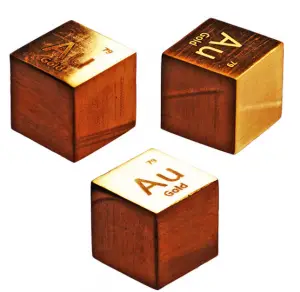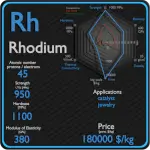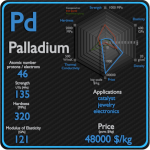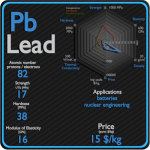This article contains comparison of key thermal and atomic properties of palladium and gold, two comparable chemical elements from the periodic table. It also contains basic descriptions and applications of both elements. Palladium vs Gold.

Palladium and Gold – About Elements


Source: www.luciteria.com
Palladium and Gold – Applications
Palladium
More than half the supply of palladium and its congener platinum is used in catalytic converters, which convert as much as 90% of the harmful gases in automobile exhaust into less noxious substances. Palladium is also used in electronics, dentistry, medicine, hydrogen purification, chemical applications, groundwater treatment, and jewelry. Palladium-based alloys are being extensively used in fuel cell technology applications. The metal is also employed in historic photographic printing process. Palladium has been used as a precious metal in jewelry since 1939 as an alternative to platinum in the alloys called “white gold”.
Gold
Gold is used extensively in jewellery, either in its pure form or as an alloy. About 75% of all gold produced is used in the jewelry industry. Pure gold is too soft to stand up to the stresses applied to many jewelry items. Craftsmen learned that alloying gold with other metals such as copper, silver, and platinum would increase its durability. The term ‘carat’ indicates the amount of gold present in an alloy. 24-carat is pure gold, but it is very soft. 18- and 9-carat gold alloys are commonly used because they are more durable. Gold’s high malleability, ductility, resistance to corrosion and most other chemical reactions, and conductivity of electricity have led to its continued use in corrosion resistant electrical connectors in all types of computerized devices (its chief industrial use). Gold is also used in infrared shielding, colored-glass production, gold leafing, and tooth restoration. Only 10% of the world consumption of new gold produced goes to industry, but by far the most important industrial use for new gold is in fabrication of corrosion-free electrical connectors in computers and other electrical devices.
Palladium and Gold – Comparison in Table
| Element | Palladium | Gold |
| Density | 12.023 g/cm3 | 19.3 g/cm3 |
| Ultimate Tensile Strength | 135 MPa | 220 MPa |
| Yield Strength | 30 MPa | 205 MPa |
| Young’s Modulus of Elasticity | 121 GPa | 79 GPa |
| Mohs Scale | 4.8 | 2.75 |
| Brinell Hardness | 320 MPa | 190 MPa |
| Vickers Hardness | 400 MPa | 215 MPa |
| Melting Point | 1554.9 °C | 1064 °C |
| Boiling Point | 2963 °C | 2970 °C |
| Thermal Conductivity | 72 W/mK | 320 W/mK |
| Thermal Expansion Coefficient | 11.8 µm/mK | 14.2 µm/mK |
| Specific Heat | 0.24 J/g K | 0.128 J/g K |
| Heat of Fusion | 17.6 kJ/mol | 12.55 kJ/mol |
| Heat of Vaporization | 357 kJ/mol | 334.4 kJ/mol |












